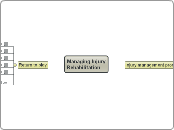af simon radford 15 år siden
387
Managing Injury Rehabilitation
Critical Q- How is injury rehabiliatation managed?

af simon radford 15 år siden
387

Mere som dette
Varies between sports. generally includes medical clearance, discussion of the use of strapping/bracing/taping, fitness assessment and specific skills tests. Even greater stringency may be used for head injuries, especially if they have occurred more than once.
Warm-up after injury may need to be more specific to the injured area.
Confidence and positive outlook will enhance prevention of re-injury. Return to soon, despite motivation (positive or negative) to do so may invite re-injury.
Use of pre (in this case before injury) and post-test results (after injury) to see if components of fitness have returned to pre injury state.
These include elasticity and strength of new tissue, mobility (has R.O.M returned), pain free movement (light and heavy exercise) and balance.